Lecture 7
DANL 200: Introduction to Data Analytics
Byeong-Hak Choe
September 20, 2022
Announcement
Tutoring and TA-ing Schedules
- Marcie Hogan (Tutor for DANL 100):
- Sunday, 2:00 PM--5:00 PM
- Wednesday, 12:30 PM--1:30 PM
- Andrew Mosbo (Tutor):
- Mondays, 4:00 PM--5:00 PM
- Wednesdays, 11:00 A.M.--noon
- Thursdays, 5:00 PM--6:00 PM
- Emine Morris (TA):
- Mondays and Wednesdays, 5:00 PM--6:30 PM
- Tuesdays and Thursdays, 3:00 PM--4:45 PM
Workflow
Shortcuts for RStudio and RScript
Mac
- command + shift + N opens a new RScript.
- command + return runs a current line or selected lines.
- command + shift + C is the shortcut for # (commenting).
- option + - is the shortcut for
<-.
Windows
- Ctrl + Shift + N opens a new RS-cript.
- Ctrl + return runs a current line or selected lines.
- Ctrl + Shift + C is the shortcut for # (commenting).
- Alt + - is the shortcut for
<-.
Workflow
- Home/End moves the blinking cursor bar to the beginning/End of the line.
- Ctrl (command/fn for Mac Users) + / works too.
- PgUp/PgDn moves the blinking cursor bar to the top/bottom line of the script on the screen.
- Fn + / works too.
- Ctrl (command for Mac Users) + Z undoes the previous action.
- Ctrl (command for Mac Users) + Shift + Z redoes when undo is executed.
- Ctrl (command for Mac Users) + F is useful when finding a phrase (and replace the phrase) in the RScript.
- Ctrl (command for Mac Users) + D deletes a current line.
About the dataset for Question 3 in Homework Assignment 1
- The geographic and time units of observation (row) in the dataset,
NY_school_enrollment_socioecon.csv, are New York county and year.
| FIPS | year | county_name | pincp | c01_001 | c02_002 |
|---|---|---|---|---|---|
| 36001 | 2015 | Albany | 55793 | 84463 | 4.7 |
For example, the observation above means that in Albany county in year 2015 ...
- Personal income of people is $55,793.
- Population 3 years and over enrolled in school is 84,463.
- Percent of population 3 years and over enrolled in nursery school and preschool is 4.7%.
Data Visualization - First Steps
Graphing Template
- To make a ggplot plot, replace the bracketed sections in the code below with a
data.frame, ageomfunction, or a collection of mappings such asx = VAR_1andy = VAR_2.
ggplot(data = <DATA>) + <GEOM_FUNCTION>(mapping = aes(<MAPPINGS>))Aesthetic Mappings and Facets
Class Exercises
- Use the following data.frame.
tvshows_web <- read_csv( 'https://bcdanl.github.io/data/tvshows.csv')Describe the relationship between audience size (
GRP) and audience engagement (PE) usingggplot. Explain the relationship in words.What aesthetic property would you consider?
Would you do faceting?
Geometric Objects
Geometric Objects
How are these two plots similar?
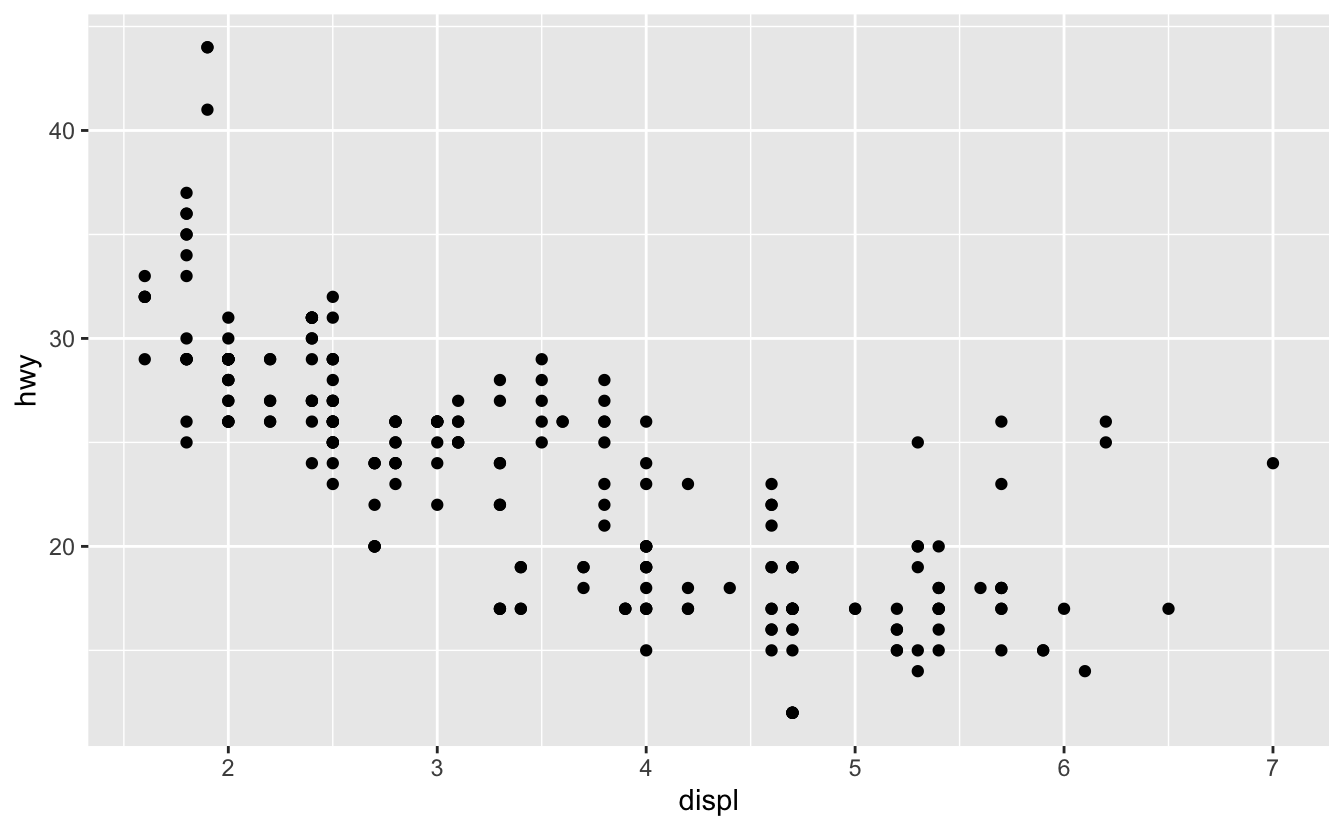
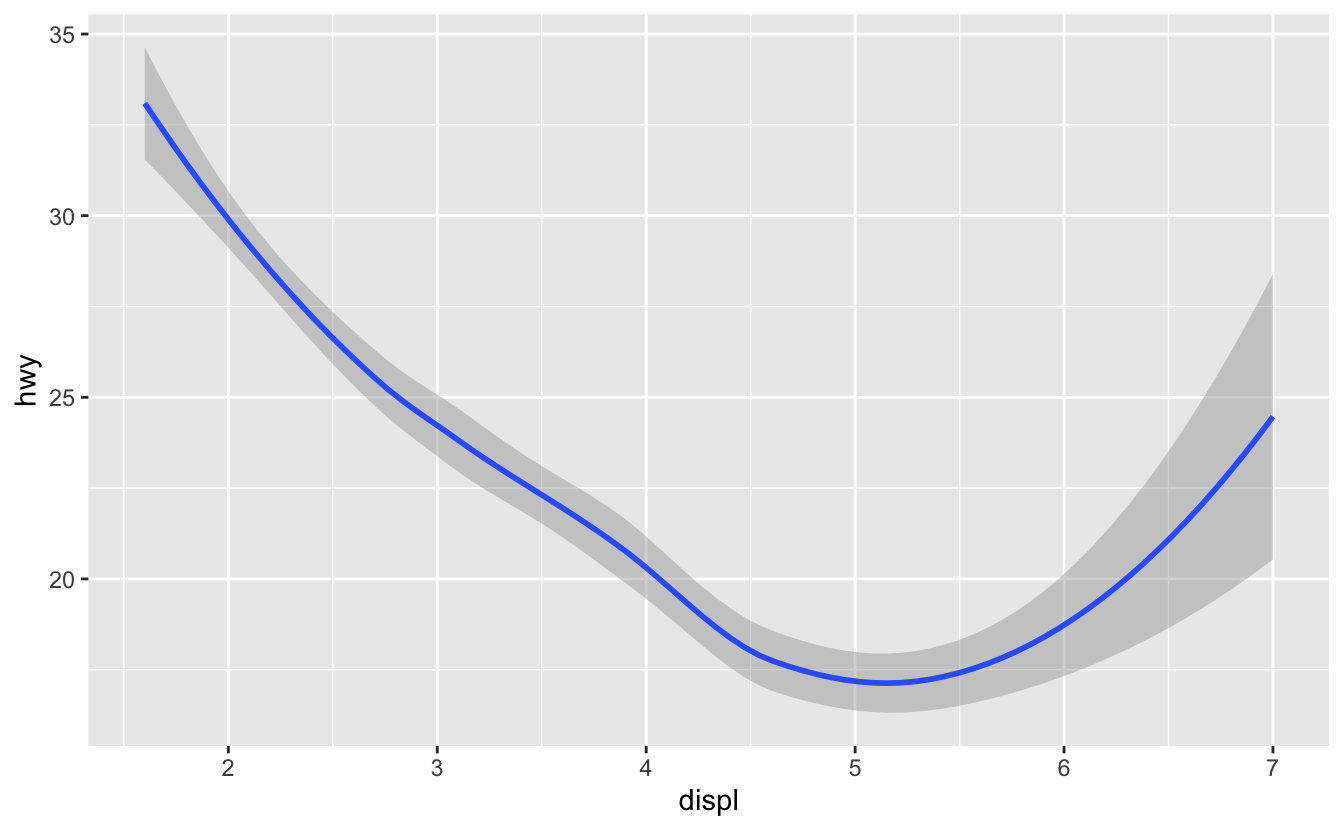
Geometric Objects
A
geom_*()is the geometrical object that a plot uses to represent data.- Bar charts use
geom_bar(); - Line charts use
geom_line(); - Boxplots use the
geom_boxplot(); - Scatterplots use the
geom_point(); - Fitted lines use the
geom_smooth(); - and many more!
- Bar charts use
We can use different
geom_*()to plot the same data.
Geometric Objects
- To change the geom in your plot, change the geom function that you add to
ggplot().
ggplot(data = mpg) + geom_point(mapping = aes(x = displ, y = hwy))
ggplot(data = mpg) + geom_smooth(mapping = aes(x = displ, y = hwy))
Geometric Objects
geom_*() Functions and Aesthetic mappings
Every
geom_*()function takes specific mapping arguments.- Not every aesthetic property works with every
geom_*()function. - For example, you can set the
shapeof ageom_point(), but you cannot set theshapeof ageom_smooth(); - You could set the
linetypeof ageom_smooth().
- Not every aesthetic property works with every
ggplot( data = mpg ) + geom_smooth( mapping = aes( x = displ, y = hwy), linetype = 3)Geometric Objects
geom_*() functions and group aesthetic
You can set the
groupaesthetic to a categorical variable to draw multiple objects.ggplot2will draw a separate object for each unique value of the grouping variable.
ggplot(data = mpg) + geom_smooth(mapping = aes(x = displ, y = hwy))ggplot(data = mpg) + geom_smooth(mapping = aes(x = displ, y = hwy, group = drv))Geometric Objects
geom_*() functions and group aesthetic
- In practice,
ggplot2will automatically group the data for thesegeomswhenever you map an aesthetic to a discrete variable (as in thelinetypeexample).
ggplot(data = mpg) + geom_smooth( mapping = aes(x = displ, y = hwy, color = drv), show.legend = FALSE )Geometric Objects
Multiple geom_*() functions
- To display multiple geometric objects in the same plot, add multiple
geom_*()functions toggplot():
ggplot(data = mpg) + geom_point(mapping = aes(x = displ, y = hwy)) + geom_smooth(mapping = aes(x = displ, y = hwy))Geometric Objects
Multiple geom_*() functions
- If you place mappings in a
geom_*()function,ggplot2will treat them as local mappings for the layer.
ggplot(data = mpg, mapping = aes(x = displ, y = hwy)) + geom_point(mapping = aes(color = class)) + geom_smooth()Geometric Objects
Multiple geom_*() functions
- You can use the same idea to specify different data for each layer.
Here, our smooth line displays just a subset of the
mpgdataset, thesubcompactcars.The local data argument in
geom_smooth()overrides the global data argument inggplot()for that layer only.
ggplot(data = mpg, mapping = aes(x = displ, y = hwy)) + geom_point(mapping = aes(color = class)) + geom_smooth(data = filter(mpg, class == "subcompact"), se = FALSE)Statistical Transformation
Statistical Transformations
Bar charts seem simple, but they are interesting because they reveal something subtle about plots.
Consider a basic bar chart, as drawn with
geom_bar().The following bar chart displays the total number of diamonds in the
ggplot2::diamondsdataset, grouped bycut.
ggplot(data = diamonds) + geom_bar(mapping = aes(x = cut))- The
diamondsdataset comes inggplot2and contains information about ~54,000 diamonds, including theprice,carat,color,clarity, andcutof each diamond.
Statistical Transformations
Many graphs, including bar charts, calculate new values to plot:
geom_bar(),geom_histogram(), andgeom_freqpoly()bin your data and then plot bin counts, the number of observations that fall in each bin.geom_smooth()fits a model to your data and then plot predictions from the model.geom_boxplot()compute a summary of the distribution and then display a specially formatted box.
Statistical Transformations
The algorithm used to calculate new values for a graph is called a
stat, short for statistical transformation.The figure below describes how this process works with
geom_bar().
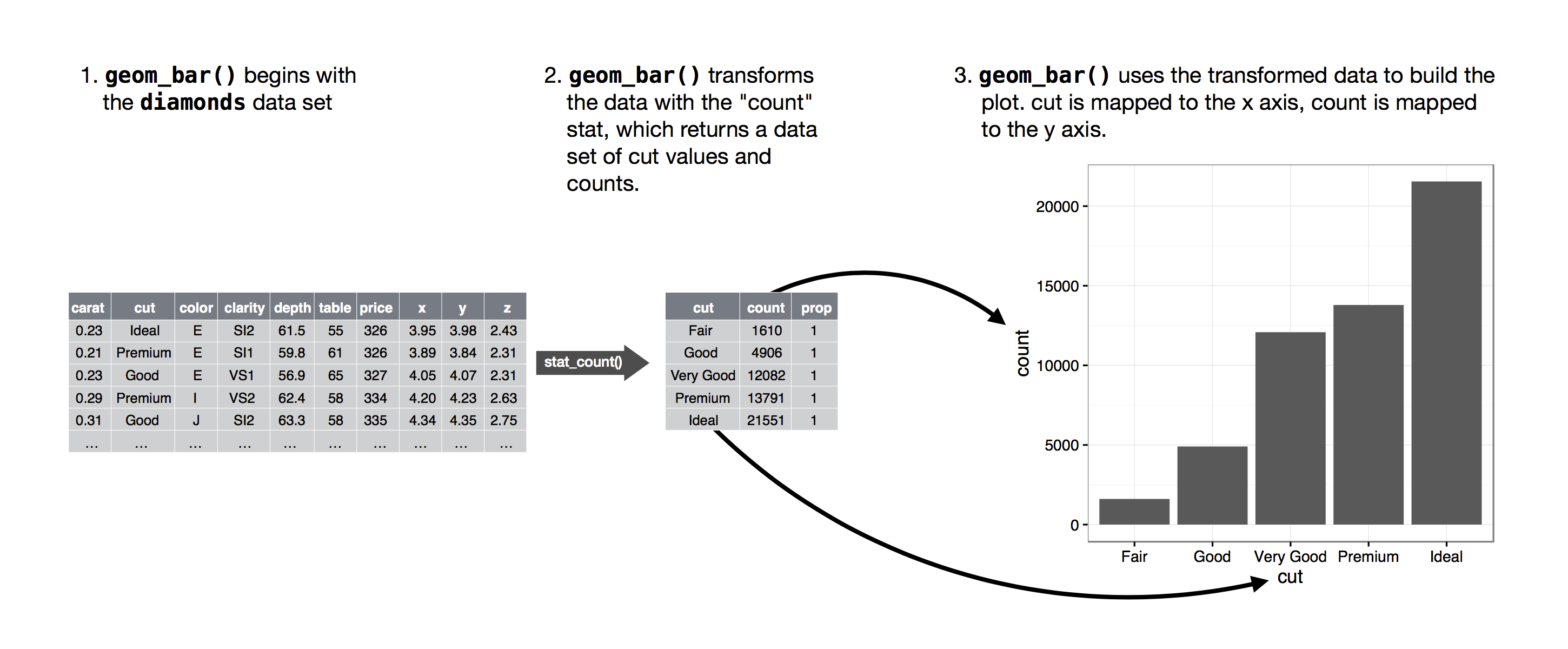
Statistical Transformations
Observed Value vs. Number of Observations
There are three reasons you might need to use a
statexplicitly:- 1. You might want to override the default
stat.
- 1. You might want to override the default
demo <- tribble( # for a simple data.frame ~cut, ~freq, "Fair", 1610, "Good", 4906, "Very Good", 12082, "Premium", 13791, "Ideal", 21551 )ggplot(data = demo) + geom_bar(mapping = aes(x = cut, y = freq), stat = "identity")Statistical Transformations
Count vs. Proportion
There are three reasons you might need to use a
statexplicitly:- 2. You might want to override the default mapping from transformed variables to aesthetics.
ggplot(data = diamonds) + geom_bar(mapping = aes(x = cut, y = stat(prop), group = 1))Statistical Transformations
Stat summary
There are three reasons you might need to use a
statexplicitly:- 3. You might want to draw greater attention to the statistical transformation in your code.
ggplot(data = diamonds) + stat_summary( mapping = aes(x = cut, y = depth), fun.min = min, fun.max = max, fun = median )Statistical Transformations
Exercises
What is the default geom associated with
stat_summary()? How could you rewrite the previous plot to use that geom function instead of the stat function?What does
geom_col()do? How is it different togeom_bar()?Most
geomsandstatscome in pairs that are almost always used in concert. Read through the documentation and make a list of all the pairs. What do they have in common?What variables does
stat_smooth()compute? What parameters control its behavior?
Statistical Transformations
Exercises
- In our proportion bar chart, we need to set
group = 1. Why? In other words what is the problem with these two graphs?
ggplot(data = diamonds) + geom_bar(mapping = aes(x = cut, y = stat(prop) ) )ggplot(data = diamonds) + geom_bar(mapping = aes(x = cut, y = stat(prop), fill = color ) )Position Adjustment
Position Adjustments
Stacked bar charts with fill aesthetic
- Note that the bars are automatically stacked if you map the
fillaesthetic to another variable.
ggplot(data = diamonds) + geom_bar(mapping = aes(x = cut, fill = clarity) )
Position Adjustments
Stacked bar charts with fill aesthetic
- The
stacking is performed automatically by the position adjustment specified by thepositionargument.
ggplot(data = diamonds) + geom_bar(mapping = aes(x = cut, fill = clarity), position = "stack")
Position Adjustments
position = "fill" and position = "dodge"
- If you don't want a stacked bar chart with counts, you can use one of two other
positionoptions:fillordodge.
position = "fill"works like stacking, but makes each set of stacked bars the same height.- This makes it easier to compare proportions across groups.
ggplot(data = diamonds) + geom_bar(mapping = aes(x = cut, fill = clarity), position = [?])position = "dodge"places overlapping objects directly beside one another.
ggplot(data = diamonds) + geom_bar(mapping = aes(x = cut, fill = clarity), position = [?])Position Adjustments
Overplotting and position = "jitter"
The values of
hwyanddisplare rounded so the points appear on a grid and many points overlap each other.- This problem is known as overplotting.
You can avoid the overlapping problem by setting the position adjustment to
jitter.position = "jitter"adds a small amount of random noise to each point.
ggplot(data = mpg) + geom_point(mapping = aes(x = displ, y = hwy), position = [?])Position Adjustments
Exercises
- What is the problem with this plot? How could you improve it?
ggplot(data = mpg, mapping = aes(x = cty, y = hwy)) + geom_point()What parameters to
geom_jitter()control the amount of jittering?Compare and contrast
geom_jitter()withgeom_count().What’s the default position adjustment for
geom_boxplot()? Create a visualization of thempgdataset that demonstrates it.
Coordinate
Coordinate Systems
The default coordinate system is the Cartesian coordinate system where the
xandypositions act independently to determine the location of each point.There are a number of other coordinate systems that are occasionally helpful.
Coordinate Systems
coord_flip()
coord_flip()switches thexandyaxes.This is useful (for example), if you want horizontal boxplots.
It's also useful for long labels: it's hard to get them to fit without overlapping on the
x-axis.
ggplot(data = mpg, mapping = aes(x = class, y = hwy)) + geom_boxplot()ggplot(data = mpg, mapping = aes(x = class, y = hwy)) + geom_boxplot() + coord_flip()Coordinate Systems
coord_quickmap()
coord_quickmap()sets the aspect ratio correctly for maps.
county <- map_data("county") # Map data for US Countiesny <- filter(county, # We will discuss 'filter()' in the next chapter region == "new york")ggplot(ny, aes(long, lat, group = group)) + geom_polygon(fill = "white", color = "black")ggplot(ny, aes(long, lat, group = group)) + geom_polygon(fill = "white", color = "black") + coord_quickmap()Coordinate Systems
Exercises
What does
labs()do? Read the documentation.What does the plot below tell you about the relationship between city and highway mpg? Why is
coord_fixed()important? What doesgeom_abline()do?
ggplot(data = mpg, mapping = aes(x = cty, y = hwy)) + geom_point() + geom_abline() + coord_fixed()ggplot Grammar
The Layered Grammar of Graphics
- Let's add position adjustments, stats, coordinate systems, and faceting to our code template.
ggplot(data = <DATA>) + <GEOM_FUNCTION>( mapping = aes(<MAPPINGS>), stat = <STAT>, position = <POSITION>) + <COORDINATE_FUNCTION> + <FACET_FUNCTION>- The seven parameters---(1) a dataset, (2) a geom, (3) a set of mappings, (4) a stat, (5) a position adjustment, (6) a coordinate system, and (7) a faceting scheme---in the template compose the grammar of graphics, a formal system for building plots.
Exploraty Data Analysis I
Exploraty Data Analysis
Get to know data before modeling
- We need to explore the data before building the model.
- No dataset is perfect.
- You'll have a more specific idea of what information most accurately predicts the probability of insurance coverage.
- Data exploration uses a combination of ...
- Summary statistics
- Visualization
- Data transformation
Exploraty Data Analysis
Example
Suppose your goal is to build a model to predict which of our customers don't have health insurance.
We've collected a dataset of customers whose health insurance status you know.
We've also identified some customer properties that you believe help predict the probability of insurance coverage:
- age
- employment status
- income
- information about residence and vehicles, and so on
Summary Statistics
Summary Statistics
- Use the
summary()orskimr::skim()command to take your first look at the data.- They report a variety of summary statistics on the numerical variables of the data frame, and count statistics on any categorical variables.
library(tidyverse)library(skimr)path <- "PATH_NAME_FOR_THE_FILE_custdata.RDS"customer_data <- readRDS(path)# The following is the same data file in my website.path_web <- "https://bcdanl.github.io/data/custdata.csv"customer_data <- read.table(path_web, sep = ',', header = TRUE)skim(customer_data)Summary Statistics
Typical problems revealed by data summaries
At this stage, we're looking for several common issues:
- Missing values
- Invalid values and outliers
- Data ranges that are too wide or too narrow
- The units of the data
Generally, the goal of modeling is to make good predictions on typical cases, or to identify causal relationships.
A model that is highly skewed to predict a rare case correctly may not always be the best model overall.
Summary Statistics
Missing values
The variable
is_employedis missing for more than a third of the data.- Why?
## is_employed## FALSE: 2321## TRUE :44887## NA's :24333Summary Statistics
Data range and variation
We should pay attention to how much the values in the data vary.
- Outliers are data points that fall well out of the range of where you expect the data to be.
skim(customer_data$income)skim(customer_data$age)Summary Statistics
Units
- We may not know that variable
IncomeKis defined as
IncomeK=customer_data$income/1000.
- Looking only at the summary, the values could plausibly be interpreted to mean either "hourly wage" or "yearly income in units of $1,000."
IncomeK <- customer_data$income/1000skim(IncomeK)- This is actually something that we’ll catch by checking data definitions in data dictionaries or documentation, rather than in the summary statistics.
Visualization
Key Points in Visualization
A graphic should display as much information as it can, with the lowest possible cognitive strain to the viewer.
Strive for clarity. Make the data stand out. Specific tips for increasing clarity include these:
- Avoid too many superimposed elements, such as too many curves in the same graphing space.
- Find the right aspect ratio and scaling to properly bring out the details of the data.
- Avoid having the data all skewed to one side or the other of your graph.
Visualization is an iterative process. Its purpose is to answer questions about the data.
Visualization
Visually checking distributions for a single variable
- We will look at histograms, density plots, bar charts, and dot plots.
The above visualizations help us answer questions like these:
What is the peak value of the distribution?
How many peaks are there in the distribution (unimodality versus bimodality)?
How normal is the data?
How much does the data vary? Is it concentrated in a certain interval or in a certain category?
Visualization
Visually checking distributions for a single variable
- One of the things that’s easy to grasp visually is the shape of the distribution of variable.
ggplot(data = customer_data) + geom_density( mapping = aes(x = age) )- The graph here is somewhat flattish between the ages of about 25 and about 60, falling off slowly after 60.
- There seems to be a peak at around the late-20s to early 30s range, and another in the early 50s.
- This data has multiple peaks: it is not unimodal.
- Distribution peaks around mid/late 20s. Peaks again in early 50s.
Visualization
Visually checking distributions for a single variable
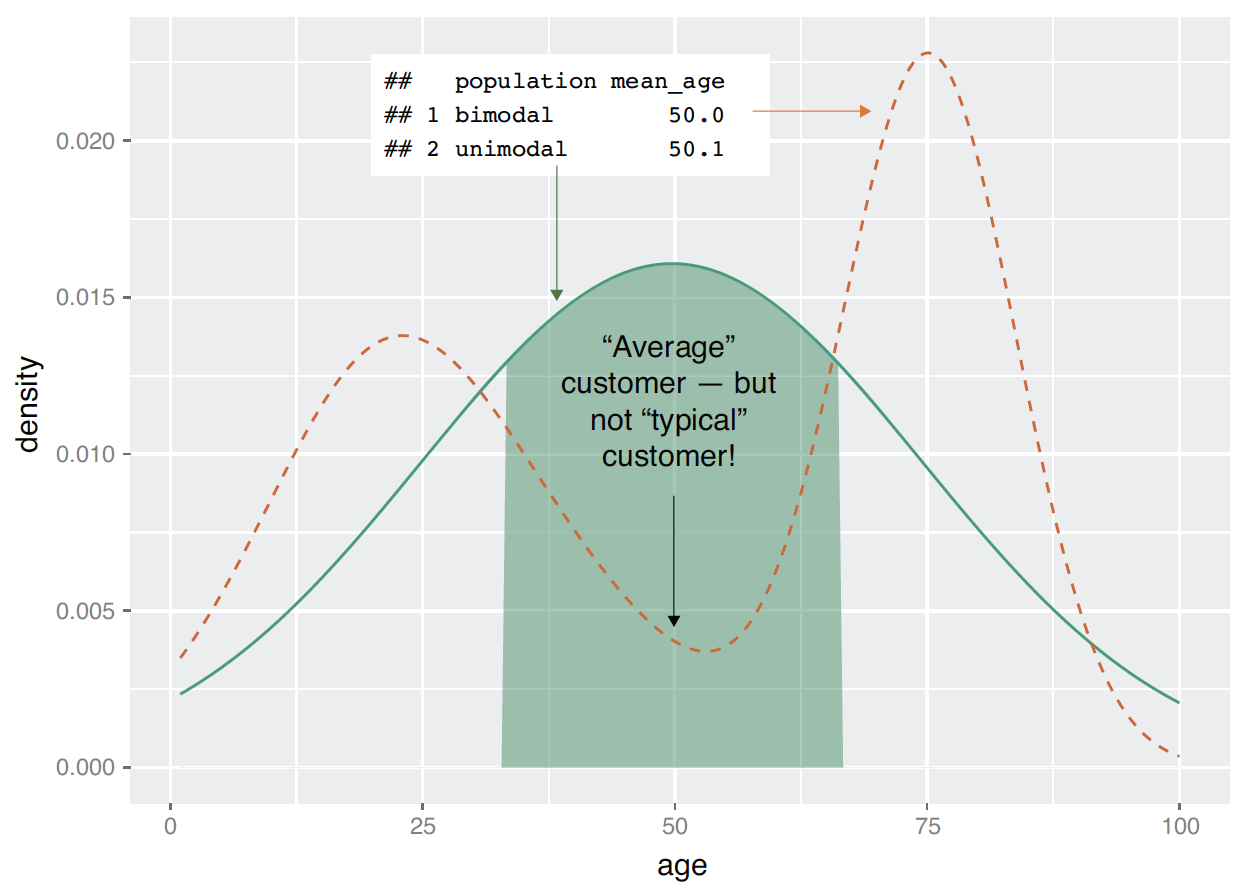
Visualization
Histograms
A basic histogram bins a variable into fixed-width buckets and returns the number of data points that fall into each bucket as a height.
A histogram tells you where your data is concentrated. It also visually highlights outliers and anomalies.
ggplot( data = customer_data, aes(x=gas_usage) ) + geom_histogram( binwidth=10, fill="gray" )skim(customer_data$gas_usage)Visualization
Data dictionary entry for gas_usage
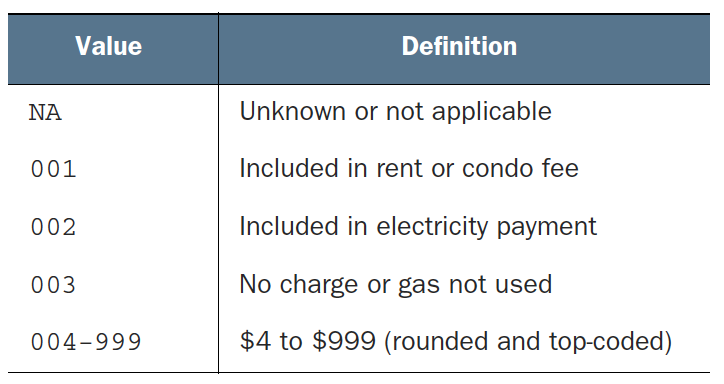
- Treat values
001,002, and003as numerical values could potentially lead to incorrect conclusions in our analysis.
Visualization
Density plots
We can think of a density plot as a continuous histogram of a variable.
- The area under the density plot is re-scaled to equal one.
- We can think of a density plot as a continuous histogram of a variable.
library(scales) # to denote the dollar sign in axesggplot(customer_data, aes(x=income)) + geom_density() + scale_x_continuous(labels=dollar)Visualization
A Little Bit of Math for Logarithm
- The logarithm function, y=logb(x), looks like ....
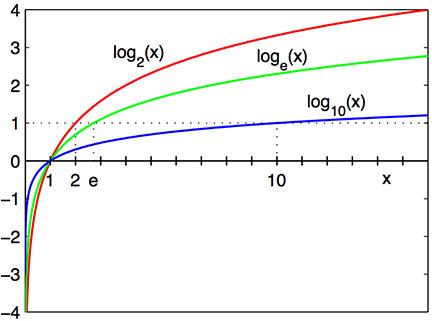
log10(100): the base 10 logarithm of 100 is 2, because 102=100
loge(x): the base e logarithm is called the natural log, where $e = 2.718\cdots$'' is the mathematical constant, the Euler's number.
log(x) or ln(x): the natural log of x .
loge(7.389⋯): the natural log of 7.389⋯ is 2, because e2=7.389⋯.
Visualization
Log Transformation
We should use a logarithmic scale when percent change, or change in orders of magnitude, is more important than changes in absolute units.
A difference in income of $5,000 means something very different across people with different income levels.
- We should also consider using a log scale to reduce a variance of residuals when a variable is heavily skewed.
Visualization
Log Transformation
- The log transformation makes the skewed distribution of income more normal.
ggplot(customer_data, aes(x=income)) + geom_density() + scale_x_log10(breaks = c(10, 100, 1000, 10000, 100000, 1000000), labels=dollar)Visualization
Bar Charts and Dotplots
- A bar chart is a histogram for discrete data.
- It records the frequency of every value of a categorical variable.
ggplot( data = customer_data, mapping = aes( x = marital_status ) ) + geom_bar( fill="gray" )Visualization
Bar Charts and Dotplots
- Bar charts are most useful when the number of possible values is fairly large, like state of residents.
ggplot(customer_data, aes(x=state_of_res)) + geom_bar(fill="gray") + coord_flip()- A horizontal bar chart can be easier to read when there are several categories with long names.
Visualization
Bar Charts and Dotplots
- Sometimes it is better to sort the data when plotting a bar chart or dot plot.
library(WVPlots) # install.package("WVPlots") if you have notClevelandDotPlot(customer_data, "state_of_res", sort = 1, title="Customers by state") + coord_flip()- Sorted bar chart or dot plot can allow use to extract insight more efficiently from the data.
Visualization
Visually checking relationships between two variables
We'll often want to look at the relationship between two variables.
Is there a relationship between the two inputs---age and income---in my data?
If so, what kind of relationship, and how strong?
Is there a relationship between the input, marital status, and the output, health insurance? How strong?
Visualization
A relationship between age and income
- Reasonable age and income values can be selected.
- We'll discuss the
filter()function soon.
- We'll discuss the
customer_data2 <- filter(customer_data, 0 < age & age < 100 & 0 < income & income < 200000)cor(customer_data$age, customer_data$income)Visualization
A relationship between age and income
ggplot( data = customer_data2 ) + geom_smooth( mapping = aes(x = age, y = income) )ggplot(customer_data2, aes(x=age, y=income)) + geom_point() + geom_smooth() + ggtitle("Income as a function of age")library(hexbin) # install.packages("hexbin) if you have not.ggplot(customer_data2, aes(x=age, y=income)) + geom_hex() + geom_smooth(color = "red", se = F) + ggtitle("Income as a function of age")Visualization
A relationship between marital status and health insurance
- Bar charts can be used to describe a relationship between two categorical variables.
ggplot(customer_data, aes(x=marital_status, fill=health_ins)) + geom_bar()# side-by-side bar chartggplot(customer_data, aes(x=marital_status, fill=health_ins)) + geom_bar([?])# stacked bar chartggplot(customer_data, aes(x=marital_status, fill=health_ins)) + geom_bar([?])Visualization
The Distribution of Marriage Status across Housing Types
cdata <- filter(customer_data, !is.na(housing_type))ggplot(cdata, aes(x=housing_type, fill=marital_status)) + geom_bar(position = "dodge") + scale_fill_brewer(palette = "Dark2") + coord_flip()ggplot(cdata, aes(x=marital_status)) + geom_bar(fill="darkgray") + facet_wrap(~housing_type, scale="free_x") + coord_flip()Visualization
Visually checking relationships between two variables
Overlaying, faceting, and several aesthetics should always be considered with the following geometric objects:
- Scatter plot
- Smoothing curve
- Bar chart
- Stacked bar chart
- Side-by-side bar chart
- Density plot
- Histogram
- Frequency ploygon
- Hexbin plot

